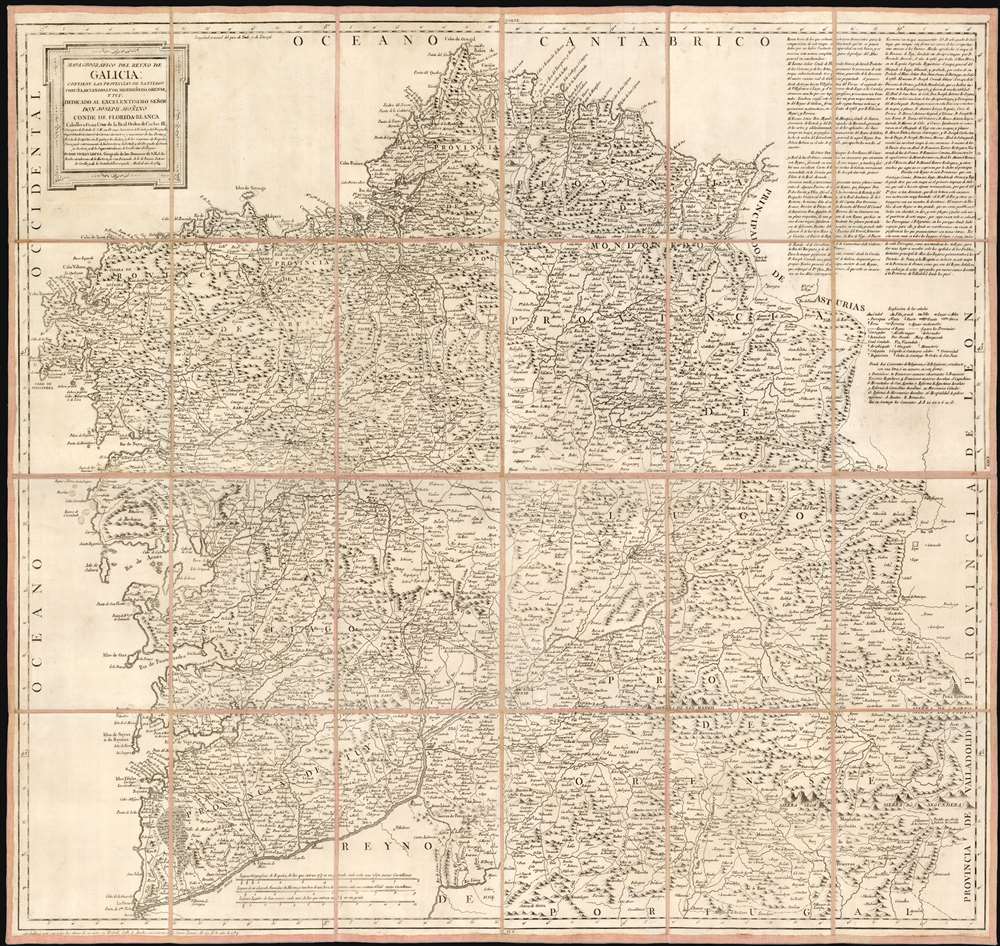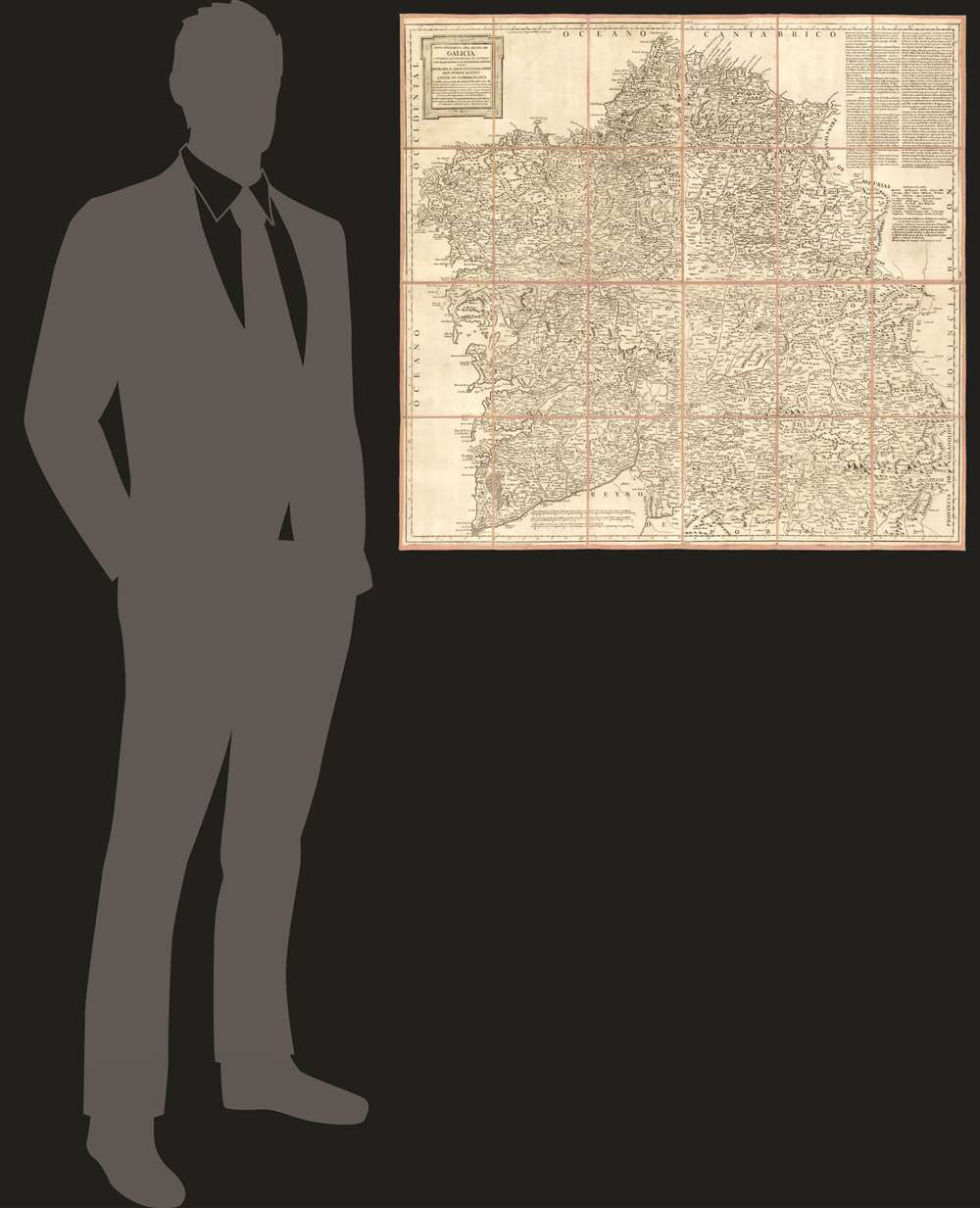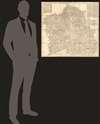This item has been sold, but you can get on the Waitlist to be notified if another example becomes available, or purchase a digital scan.
1784 Lopez Map of the Kingdom of Galicia
Galicia-lopez-1784
Title
1784 (dated) 30.75 x 32.75 in (78.105 x 83.185 cm) 1 : 330000
Description
Se puede decir que este mapa es el primero impreso de Galicia... porque el del Pe. Ojea es tan diminuto, que de su lectura solo sacamos una instruccion muy limitada; el de Mr. De Fer y otros estrangeros son un monton de desalinos.López's boast is not baseless. The map of Hernando Ojea (1543 - 1615) to which he refers was first committed to print in the 1603 J.B. Vrients edition of the Ortelius atlas (he obtained a manuscript from Ojea.) This, in absolute terms, was the first printed map of Galicia, and was considered sufficiently correct that virtually every map printed of Galicia in that century was copied directly from it. Even so, in terms of detail López's criticism of the Ojea is valid: its scale limits detail. The maps of De Fer - which appear to be derived from, or from the same sources as the Cantelli and the Coronelli maps - did contain more data than their precursor, but even if they did not deserve the appellation un monton de desalinos, None approach this López map in either size or detail. Lopez credits an impressive array of sources - in sum, the map compiled a wealth of state-of-the-art data from a roster dominated by leading lights of the Spanish Enlightenment. They include the statesman Gaspar Melchor de Jovellanos (1744 - 1811); Pedro Varela y Ulloa (1737- 1797), then an official of the Secretary of State, who would eventually become Secretary of the Navy. Particular credit was given to José Andrés Cornide de Folgueira y Saavedra (D. Joseph Cornide; 1737 - 1803), a noted Galician geographer, naturalist and humanist
'It can be said that this map is the first printed of Galicia... because that of Father Ojea is so tiny, that from its reading we only get a very limited instruction; those of Mr. De Fer and other foreigners are a bunch of slops.'
A Closer Look
This large map offers a wealth of placenames - many appearing on a map for the first time. Mountains are illustrated pictorially. Cities, large towns, villas and villages are marked distinctively with an array of symbols keyed to a legend to indicate the presence in those locations of different elements of religious or governmental administration - for example, specific symbols show archbishoprics, monasteries, forts, fairs, smithies - or the Spanish Inquisition (which we were not expecting).Publication History and Census
The map was printed to four sheets, first as a separate issue in 1784, and thereafter in López's posthumousAtlas Geografico de Espana, which was printed in 1804 by his heirs, and appeared in further editions in 1810 and 1830. The separate first edition map is scarce; we are aware of just fourteen examples catalogued in institutional collections.Cartographer
Tomás López de Vargas Machuca (1730 - July 19, 1802) was a Spanish cartographer active in the later part of the 18th century. Vargas was born in Toledo and studied mathematics, grammar, and rhetoric at the Colegio Imperial in Madrid. In 1752, with the patronage of the Marquis de la Ensenada, he relocated to Paris to study. López attended the Mazarin College, where he received two courses in Mathematics and lessons in geography from the Abbé de la Caille, Joseph Jérome de Lalande, and Louis Gabriel. He also studied cartography direclty under the legendary French mapmaker Jean Baptiste Bourguignon d'Anville (1697 - 1782). Back in Madrid, he collaborated with the geographer Juan de la Cruz on two educational atlases, published in 1757 and 1758. Around 1770, King Carolos III, appointed him Geógrafo de los Dominios de Su Magestad and gave him charge over the newly created Gabinete de Geografía. In this position, he dedicated the remainder of his life to a detailed mapping of Spain, producing numerous important regional maps, many correcting common mistakes made by foreign geographers. He also ran a private map publishing business in Madrid, first on San Bernardo (1761 - 65), the on Las Carretas (opposite Gamete; 1765 - 1783), and infamy on Atocha (1783 - 1802). He was a member of the Real Academia de San Fernando, the Real Sociedad Bascongada de Amigos del País and the Academia de Bellas Letras de Sevilla. López was succeeded by his two sons, also cartographers, who published several atlases based upon his work. The appraisal of his estate at the time was 489,800 reales (about 1,000,000 USD today), a figure indicative of his success. More by this mapmaker...




